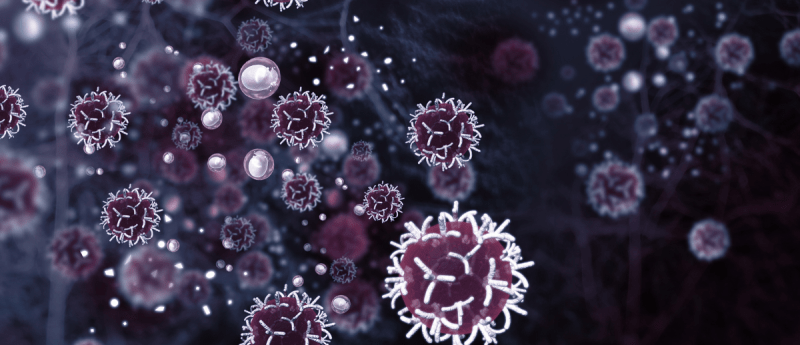Next-gen CAR-T therapy: innovations, challenges and future directions


In this interview, Tong Huo discusses the current landscape of CAR-T therapies and the future of CAR-T, including next-generation approaches, gene-editing innovations and applications beyond oncology.
Tong Huo is a Product Manager at Sino Biological. He is in charge of the protein product strategy, including product marketing, product development and product line optimization. Before joining Sino Biological, Tong obtained his PhD in Biochemistry and Molecular Biology from Nankai University (Tianjin, China). After graduation, he completed his post-doctoral training and worked as a research scientist at the Baylor College of Medicine (TX, USA). Tong’s fields of expertise include protein science, structural biology and drug discovery. He has published featured papers in high-impact journals such as JACS, Protein & Cell, JMC and more.
What are the advantages of CAR-T therapies, and how do they function in cancer treatment?
Current cancer treatments include surgery, radiation therapy, chemotherapy, immunotherapy, and precision medicine. However, CAR-T therapy is considered superior in several ways. It offers high specificity by targeting cancer-specific antigens, which minimizes damage to healthy cells. The modified T cells can also persist in the body, providing long-term protection against cancer recurrence. CAR-T therapy has shown remarkable efficacy, particularly in treating certain blood cancers like B-cell lymphomas and leukemias [1,2]. Additionally, each CAR-T treatment is personalized to the patient’s unique cancer profile, enhancing its effectiveness [3].
CAR-T therapy leverages the body’s immune system to target and eliminate cancer cells. The process begins with the collection of a patient’s T cells. Then these T cells are genetically modified to express chimeric antigen receptor (CAR) and undergo cell expansion before they can be reinfused into the patient. Upon entering the body, the CAR-T cells circulate, binding to the targeted antigen on cancer cells and further triggering the immune response.
How do next-generation CAR-T therapies differ from current CAR-T treatments?
Next-generation CAR-T therapies are designed to address the limitations of current CAR-T treatments, aiming to improve their efficacy, safety, and applicability [4]. Next-generation CAR-T therapies aim to explore a broader range of antigens, including those found on solid tumors, like MSLN, B7-H3, CEA, and MUC1 [5]. Targeting two or more targets is also considered a strategy to improve specificity and overcome antigen escape, leading to the emergence of Dual CAR-T or Multi CAR-T. Additionally, CAR constructs are being optimized or redesigned to enhance the infiltration into tumor tissues and address the tumor microenvironment [6].
The increased applicability and availability of CAR-T are also expected for next-generation CAR-T therapies. The current hurdle is that CAR-T cells have to be individually manufactured for each patient, which is not ideal for patients with rapidly progressing diseases. ‘Off-the-shelf’ (allogeneic) CAR-T cells, donated by healthy donors and prepared beforehand, can be readily used when needed, saving time and money [7].
What primary challenges do next-generation CAR-T therapies aim to address?
The primary challenge for next-generation CAR-T therapy is its effectiveness in treating solid tumors [8,9]. Currently, CAR-T therapies have successfully treated hematological malignancies due to the accessibility of blood cells. However, solid tumors, which account for many more cases, present the most significant challenge. Several solid-tumor-specific factors hinder progress, including the tumor microenvironment (TME), antigen heterogeneity, and T-cell exhaustion. Unlike blood cancers, solid tumors have a complex TME that suppresses immune cell activity and creates a native barrier that prevents CAR-T cells from effectively infiltrating and attacking the tumor. Moreover, antigens on solid tumors are very heterogeneous, making it difficult for CAR-T cells to recognize and eliminate the cancer cells. In addition, solid tumors often present a continuous and high load of antigens, leading to chronic stimulation of CAR-T cells, causing them to become exhausted and lose their effectiveness.
In what ways can gene editing techniques enhance the efficacy of CAR-T therapies?
Gene editing has made significant progress in recent years, particularly with the rise of CRISPR-Cas9 and other precise gene editing technologies. These advancements have promising applications in cancer therapies. Currently, numerous research projects are utilizing gene editing techniques to engineer CAR-T cells, aiming to enhance the therapeutic outcomes of CAR-T therapies [10]. For instance, gene editing can be used to knock out genes that cause T-cell exhaustion, such as PD-1 or CTLA-4, leading to a more sustained immune response against cancer [11].
Another example is engineering T cells to express cytokines like IL-12, which enhances their ability to target and kill cancer cells [12]. Gene editing also allows the removal of endogenous T-cell receptors, reducing the risk of graft-versus-host disease when using allogeneic (donor-derived) CAR-T cells. In summary, gene editing offers a powerful toolset to fine-tune CAR-T cells, increasing their potency, durability, and safety, ultimately leading to more effective and widely applicable cancer treatments.
How do CAR-T cells function when combined with immune checkpoint modulation?
As previously mentioned, CAR-T cells need to overcome the immunosuppressive tumor environment. One strategy for achieving this is by combining CAR-T cells with immune checkpoint modulation, which reverses immune suppression in the TME. Tumor cells often exploit immune checkpoint molecules such as PD-1/PD-L1 to evade the attack of the immune system. To this end, PD-1 knock-out CAR-T cells can be generated using gene editing techniques [13]. Immune checkpoint inhibitors can also be used while applying CAR-T therapy. When CAR-T cells are combined with immune checkpoint inhibitors, the two therapies work synergistically to improve the effectiveness of the immune response against cancer cells. Currently, clinical trials are exploring the combination of CAR-T cells with PD-1/PD-L1 inhibitors or CTLA-4 inhibitors. Preliminary results from studies in cancers such as melanoma, lung cancer, and lymphoma suggest that this approach can significantly enhance the effectiveness of CAR-T cell therapy, particularly in patients who may not have responded well to CAR-T therapy alone [14].
What are the current methods for detecting the CAR expression?
There are several methods for detecting CAR expression, with qPCR and flow cytometry (FCM) being the most prominent and widely used [15]. qPCR is a molecular biology technique that quantifies CAR-specific genetic material in a sample. It works by amplifying a DNA or RNA sequence that corresponds to the CAR sequence and measuring the quantity of this genetic material in real time during amplification. This technique is highly sensitive, capable of detecting low levels of CAR gene expression, and can accurately quantify CAR gene copy number or mRNA levels. However, qPCR measures the gene encoding the CAR, not the actual CAR protein expressed on the cell surface [16]. As a result, it often needs to be combined with FCM for a more comprehensive analysis.
FCM is a widely used technique for detecting and quantifying CAR expression directly on the surface of T cells. It involves labeling the CAR-T cells with fluorescently conjugated antibodies that specifically bind to the CAR protein or its target antigen. FCM provides precise quantification of CAR expression levels, offering insights into the cell population expressing the CAR. However, factors such as sample preparation and antibody selection can affect data quality. To minimize these variables, fluorescent-labeled antigens, particularly those with site-specific labeling, are used to enhance quality control in FCM. This method eliminates the need for additional fluorescence-labeled antibodies by directly attaching the fluorescent group to the target protein, improving the assay’s convenience and consistency [17].
What potential future applications exist for CAR-T therapies beyond oncology?
Although CAR-T cell therapies were originally developed for treating cancers, particularly hematologic malignancies, their potential applications extend beyond oncology. One of the most promising areas is in the treatment of autoimmune diseases [18]. In such conditions, the immune system – often B cells or T cells – attacks the body’s tissues. By reinfusing CAR-T cells into patients, it is possible to selectively target and eliminate these ‘autoreactive’ immune cells. For example, in diseases like systemic lupus erythematosus or multiple sclerosis, B cells produce harmful antibodies that attack the body. CAR-T cells targeting B cells, particularly those expressing CD19, can deplete these pathogenic cells, potentially halting disease progression.
How is Sino Biological contributing to the advancement of next-generation CAR-T therapies?
As a global leader in supplying bioreagents and CRO services for the biopharmaceutical industry, Sino Biological offers comprehensive solutions for CAR-T cell therapy development. Our products and services support clients at every stage, from early target discovery to the preclinical phase of research and development. With the growing number of targets being explored for CAR-T therapies, including emerging Dual-CAR and Multi-CAR approaches, Sino Biological is committed to providing a wide range of high-quality drug target proteins and antibodies to meet the rising demand and stringent standards in the CAR-T cell therapy field. Additionally, Sino Biological has developed a GMP-grade cytokine product line – including IL-2, IL-7, IL-15, and IL-21 – to enhance CAR-T cell culture and proliferation. Our commitment to excellence is demonstrated through a rigorous quality management system, pharmaceutical-grade release testing, and maintaining a pharmaceutical-grade manufacturing environment and production process.
- Maude SL, Laetsch TW, Buechner J et al. Tisagenlecleucel in children and young adults with B-cell lymphoblastic leukemia. N. Engl. J. Med. 378(5), 439–448 (2018).
- Pegram HJ, Smith EL, Rafiq S, Brentjens RJ. CAR therapy for hematological cancers: can success seen in the treatment of B-cell acute lymphoblastic leukemia be applied to other hematological malignancies? Immunotherapy 7(5), 545–561 (2015).
- June CH, O’Connor RS, Kawalekar OU, Ghassemi S, Milone MC. CAR T cell immunotherapy for human cancer. Science 359(6382), 1361–1365 (2018).
- Tomasik J, Jasiński M, Basak GW. Next generations of CAR-T cells – new therapeutic opportunities in hematology? Front. Immunol. doi:10.3389/fimmu.2022.1034707 (2022) (Online only).
- Yun Ma H, Das J, Prendergast C et al. Advances in CAR T Cell Therapy for Non-Small Cell Lung Cancer. Curr. Issues Mol. Biol. 45(11), 9019–9038 (2023).
- Rafiq S, Hackett CS, Brentjens RJ. Engineering strategies to overcome the current roadblocks in CAR T cell therapy. Nat. Rev. Clin. Oncol. 17, 147–167 (2020).
- Castelli S, Young RM, June CH. Off-the-shelf CAR T cells to treat cancer. Cell Res. 32, 1036–1037 (2022).
- Makni Maalej K, Merhi M, Inchakalody VP et al. CAR-cell therapy in the era of solid tumor treatment: current challenges and emerging therapeutic advances. Mol. Cancer 22, 20 (2023).
- Guzman G, Reed MR, Bielamowicz K, Koss B, Rodriguez A. CAR-T Therapies in Solid Tumors: Opportunities and Challenges. Curr. Oncol. Rep. 25, 479–489 (2023).
- Azangou-Khyavy M, Ghasemi M, Khanali J et al. CRISPR/Cas: From Tumor Gene Editing to T Cell-Based Immunotherapy of Cancer. Front. Immunol. doi:10.3389/fimmu.2020.02062 (2020) (Online only).
- Rupp LJ, Schumann K, Roybal KT et al. CRISPR/Cas9-mediated PD-1 disruption enhances anti-tumor efficacy of human chimeric antigen receptor T cells. Sci. Rep. 7, 737 (2017).
- Olivera I, Bolaños E, Gonzalez-Gomariz J et al. mRNAs encoding IL-12 and a decoy-resistant variant of IL-18 synergize to engineer T cells for efficacious intratumoral adoptive immunotherapy. Cell Rep. Med. 4(3), 100978 (2023).
- McGowan E, Lin Q, Ma G, Yin H, Chen S, Lin Y. PD-1 disrupted CAR-T cells in the treatment of solid tumors: Promises and challenges. Biomed. Pharmacother. 121, 109625 (2020).
- Grosser R, Cherkassky L, Chintala N, Adusumilli PS. Combination Immunotherapy with CAR T Cells and Checkpoint Blockade for the Treatment of Solid Tumors. Cancer Cell 36(5), 471–482 (2019).
- Reichman A, Kunz A, Joedicke JJ et al. Comparison of FACS and PCR for Detection of BCMA-CAR-T Cells. Int. J. Mol. Sci. 23(2), 903 (2022).
- Yamamoto S, Matsumoto S, Goto A et al. Quantitative PCR methodology with a volume-based unit for the sophisticated cellular kinetic evaluation of chimeric antigen receptor T cells. Sci. Rep. 10, 17884 (2020).
- Schanda N, Sauer T, Kunz A et al. Sensitivity and Specificity of CD19.CAR-T Cell Detection by Flow Cytometry and PCR. Cells 10(11), 3208 (2021).
- Li YR, Lyu Z, Chen Y, Fang Y, Yang L. Frontiers in CAR-T cell therapy for autoimmune diseases. Trends Pharmacol. Sci. 45(9), 839–857 (2024).
The opinions expressed in this interview are those of the interviewee and do not necessarily reflect the views of BioTechniques or Taylor & Francis Group.
This article was supported by Sino Biological.
